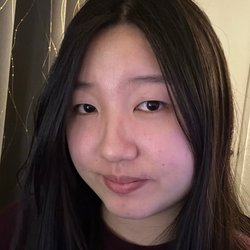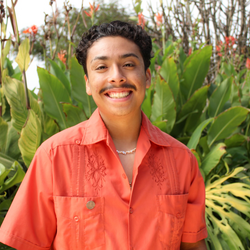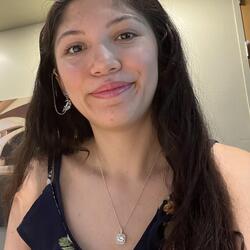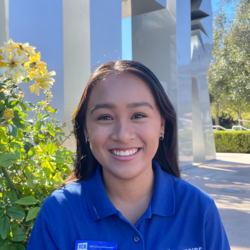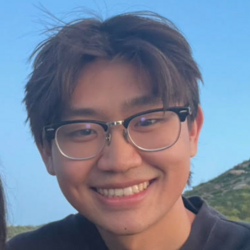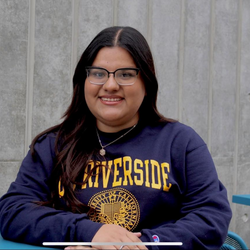Please find all research abstracts for the 2023 MSRIP Symposium Presentations below. Organized alphabetically. To view the schedule of oral and poster presentations, please click here.
-
Aerial Bridgers, Master's of Physical Chemistry
Faculty Mentor: Andrew Petit, CSUF Department of Chemistry and Biochemistry; Dr. Jingsong Zhang, UCR Department of Chemistry
Exploring the Mechanism of the Electronic Quenching of NO (A2S+) with CH4 and CO2
As a reactive atmospheric pollutant, NO has the potential to interact with other molecules in unique ways. The method of experimental detection, laser-induced fluorescence (LIF), measures NO along its A2Σ+←X2Π transition band.Electronic quenching of NO (A2Σ+) through interaction with other molecules provides alternate photochemical pathways that fluorescence must compete with. Based on experimental studies, the electronic quenching cross section of the NO (A2Σ+)+CH4 system is <0.001 Å2 at 296 K and the NO (A2Σ+)+CO2 system is 68.3 Å2 at 294 K. This indicates that at a significant level, electronic quenching is occurring for the CO2system, but is occurring at a negligible rate for the CH4 system.
In order to explore pathways for quenching of both the NO (A2Σ+)+CH4 and NO (A2Σ+)+CO2 system, the long-range interactions and conical intersections are explored through the mapping of potential energy surfaces (PESs). The PESs are calculated at the EOM-EA-CCSD/d-aug-cc-pVTZ//EOM-EA-CCSD/aug-cc-pVDZ level of theory. While exploration of the NO (A2Σ+)+CH4 system displayed that there is no obvious pathway to quenching, as expected due to the very small quenching cross-section, it did yield C3v geometric conformations for the excited state complex. For the NO (A2Σ+)+CO2 system, long range interactions between N of NO and O of CO2 are shown to be attractive, and further exploration demonstrates that this attraction increases as the distance between the molecules decreases. As the distance decreases, electronic density shifts from NO to CO2, which is known as the harpoon mechanism. An energetically downhill pathway to a conical intersection is demonstrated.
-
Ahmed Alghorydh, Neuroscience
Faculty Mentor: Dr. Weiwei Zhang, UCR Department of Psychology
Investigating the Relationship Between Behavioral Mixture Model and Neural Population Coding: A Study of Parameter Correspondence and Categorical Memory Patterns
When modeling working memory recall, researchers have explored two distinct families of models: the mixture model (also known as the slot model) and the population coding model. The mixture model proposes that working memory operates using discrete units of resources allocated to different items, while the population coding model posits that a population of neurons represents various working memory samples. Our research project aims to establish a relationship between the behavioral mixture model and the neural population coding model by investigating the correspondence between their respective parameters. We have observed that memory precision correlates with both tuning curve precision and neural gain (amplification). However, tuning curve precision appears to exert a stronger influence on the variation in memory precision compared to neural gain. Conversely, capacity, which is related to both tuning curve and gain, is predominantly affected by the neural gain parameter. In the next phase of our study, we will extend both models to accommodate categorical patterns in memory recall. To achieve this, we will modify the population coding model by adjusting the neural gain, tuning curve precision, and density of tuning curves. This extension will enable us to examine which neural parameters underlie the emergence of categorical patterns in memory recall
-
Alexandra Rochin, Education
Faculty Mentor: Dr. Covadonga Lamar Prieto, UCR Department of Hispanic Studies
Language and Healthcare in the US: Creating a curriculum for pre-med students to assess linguistic, cultural, and medical barriers for Spanish speakers in healthcare
The correlation between language and health is a factor that not only relies on communication and reliability but also efficiency and responsiveness in the context of a medical setting. While the Spanish-speaking population grows in the US, language discordance has hindered their access to quality healthcare (Martínez, 2020). We will evaluate past research on the impact of miscommunication due to language and cultural differences on the quality of healthcare and support and use our findings to craft a curriculum that addresses the needs of patients that are not being met.
The outcome of our research will support our thesis that current translation practices are lacking in efficacy, and therefore developing a curriculum to encourage healthcare professionals to speak Spanish and successfully translate medical language will improve patient outcomes. Developing this skill among medical professionals will not only close the language barrier. Still, it can address other gaps, such as cultural misunderstanding, and improve relationships between patients and caretakers in the medical setting.
By creating a curriculum for UCR pre-med students to understand the basics of Spanish in the medical field and the impact of language accessibility, we hope to improve medical outcomes for Spanish-speaking populations served by these future medical providers. Rather than adding to the list of medical lexicons that students already have to learn, this curriculum will prepare them to socialize and understand proper cultural communication in Spanish. This skill will help develop relationships between providers and patients and improve the quality of healthcare that Spanish speakers receive.
-
Alexis Flores, Chemical and Environmental Engineering
Faculty Mentor: Amanda Rupiper, Department of Chemical and Environmental Engineering
Examination of Contaminated Groundwater in Disadvantaged Communities in California
In the United States, an estimated 400 billion gallons of water are withdrawn daily from surface and groundwater for public supply, domestic, irrigation, livestock, aquaculture, industrial, mining, and thermoelectric-power generation1. In 2015, California withdrew 17,400 million gallons per day from groundwater sources and 11,300 million gallons per day of surface water2. California uses 28,000 million gallons per day for the different sectors as stated above. As we can see water is a necessary resource in the daily lives of a 21st century populace. California having semiarid conditions and experiencing drastic climate change, including drought has put a lot of strain on California's water supply. In order to meet water demands for Californians equally it is important to examine which populations may require water and if that water is safe to use. Historically disadvantaged communities have not received the same care as other communities, so this project aims at helping amend this imbalance. This research looks at groundwater levels and contamination throughout California to better understand where resources may need to be allocated. To do this, groundwater levels and contamination data were obtained from public government agencies and organized and reshaped using RStudio. The data was then mapped spatially with ArcGIS to show regions of water contamination that could be cross referenced with disadvantaged communities from the California census. Knowing which communities have scarce or unsafe water supplies will help policymakers determine where efforts should be focused.
-
Ali Kattee, Mechanical Engineering
Faculty Mentor: Dr. Konstantinos Karydis, Department of Electrical and Computer Engineering
Dynamical shape-changing terrain for robot locomotion experiments
The indoor construction of terrains is a preferred approach to robotic locomotion verification due to its convenient access to various monitoring and computing equipment that is typically hard to deploy outdoors. Some standard practices include a human arrangement of bricks, boxes, and panels, and a more uniform composition with wooden blocks. Nevertheless, robotic experiments may require different terrestrial features and it is tedious and challenging to manually reconstruct various empirical environments in a timely manner. The above issue can be overcome by automating the terrain reconstruction and the literature suggests that such automation can be achieved through shape-changing interfaces concentrating more on user haptic interaction. As an adaptation to more aggressive actions, the Walkable Pin-Array target on larger scales and heavier surface payload, yet still coerces the actuator quantity agreeing with the terrain width and the pin-locking mechanism in a row-consistent manner. To this end, we propose a scalable dynamically-reconstructable terrain that is inspired by the Pin-Array but has few limits on the actuation and the pin-locking mechanism. The terrain prototype enables an independent self- locking-unlocking mechanism for each pin without compromising the pin payload. It also features a coreXY gantry that allows rapid relocating of at minimum one linear actuator to maneuver pin's height. Online planning and control are applied to locally realize the target terrain morphology in almost real time, followed by adaptation to any global scale. In this way, the proposed terrain platform can approximate more dynamically varying environments at different scales.
-
Allison Hwang, Electrical Engineering
Faculty Mentor: Shaolei Ren, UCR Department of Electrical and Computer Engineering
Quantifying the Water Footprint of AI Computing
In recent years, there has been growing concern regarding the environmental impact of computers, specifically in terms of energy consumption and associated carbon emissions. However, the water footprint of computers remains unmonitored. In 2020, 47.5 trillion gallons of water were consumed to generate electricity. Despite the frequent usage of computers nowadays, the assessment of water usage in the context of computer operations remains overshadowed by other environmental issues. This project aims to analyze the amount of water utilized to produce electricity consumed by computers, thereby providing insights into the water footprint of these machines. Inspired by the CodeCarbon project, which successfully tracks the carbon emissions of computers, this project focuses on the water footprint of technological devices, specifically personal computers or data centers. By tracking the power usage of various computer components and taking account of the water usage by every electricity generation sector, their water consumption can be calculated. The results of this project may inform users of their computers’ water footprint.
-
America Alarcon Miranda, Chemistry
Faculty Mentor. Quan Cheng, UCR Department of Chemistry
Identifying Antibiotic Susceptibility of S. Aureus Strains via MALDI-MS
Bacteria are everywhere - some might be good enough to carry in one’s body but not all are safe. Bacteria can be very dangerous, especially to those with a weak immune system, such as those in the hospital. A wide variety of antibiotics are available to treat bacterial infections, which if administered quickly, can be lifesaving. However, in recent decades bacteria has developed resistance to some of the commonly utilized antibiotics. As such, new methodologies are needed to identify these strains before antibiotic treatment since treating patients with an antibiotic that bacterium is resistant to can do more harm than good. Methicillin-resistant staphylococcus aureus, also known as MRSA, is one of these bacteria that has led to thousands of deaths. We demonstrate the usage of matrix-assisted laser desorption ionization mass spectrometry (MALDI-MS) to explore and identify the differences in lipids between resistant and susceptible S. Aureus strains. MALDI-MS uses a laser-absorbing matrix to ionize molecules from the bacterial cells with minimum fragmentation. Using MALDI-MS we studied and identified lipid fingerprints for two bacterial strains and monitored how they respond to antibiotic treatment in order to better understand antibiotic resistance. The work offers a good understanding of strains-specific lipid composition and bacteria’s response to antibiotics to guide the treatment
-
Andrew Abdala, Chemical Engineering
Faculty Mentor: Ananta Azad, Department of Chemical Engineering
Effect of deficit irrigation and water quality on the water content and fate of Pharmaceutical and Personal Care Products (PPCPs) in food crops Irrigated
To be more efficient with water usage against water scarcity, recycled water can be used for agricultural irrigation. However, recycled water contains pharmaceuticals and personal care products (PPCPs), which can accumulate food crops. In this analysis, the food crops were under greenhouse conditions to control the climate. Applying further treatment to the wastewater, using a UV/persulfate technique, can efficiently remove PPCPs. To understand the water content and the fate of PPCPs in food crops irrigated with recycled water; lettuce, carrot, and tomato were selected as model crops. Carbamazepine (CBZ), diclofenac (DCF), and fluoxetine (FLX) were spiked at 2 μg/L in recycled water for irrigation. UV/PS was applied to efficiently remove all the PPCPs from spiked recycled water and generate treated recycled water for irrigation. Food crops were irrigated at three different water levels of 100%,80%, and 60% of reference evapotranspiration (ET0). Sonication was used to extract the PPCPs from plant biomass, and solid phase extraction (SPE) was applied to further clean the sample matrix for analysis. Results from this analysis will help determine the water content and accumulated concentration of PPCPs in lettuce irrigated with different water quality at different water levels. This research will help farmers and organizations to safely substitute treated recycled water for potable water in agriculture and help with the water scarcity issue for a promising future
-
Andro Zaki, Bioengineering
Faculty Mentor: Dr. Iman Noshadi, Department of Bioengineering
Advancing Stem Cell Bioprinting for Regenerative Engineering
The potential of 3D bioprinting for regenerative medicine is immense, spanning drug testing to crafting transplantable tissues and organs. To enhance bioprinting success, a bio-ink with an ideal microenvironment for cell health and easy printability is essential. This study aimed to tackle this challenge by formulating a bio-ink composed of bio-ionic liquid (BIL) and polyethylene glycol diacrylate (PEGDA), BioPEG, for stem cell bioprinting through digital light processing. The accuracy of BioPEG was evaluated by printing structures of varying complexity, from basic lattices to detailed heart models. Human mesenchymal stem cells (hMSCs) were seeded onto the prints to assess their compatibility using Actin/DAPI and Live/Dead staining. The results demonstrated BioPEG's exceptional printability, cytocompatibility, and the transformative potential of integrating bioprinting and stem cells in regenerative engineering.
-
Anthony Joshua Avendano, Engineering
Faculty Mentor: Neftali D. Watkinson Medina, UCR Department of Computer Science & Engineering
Quantization of LLM for edge devices
The recent development and advancements of large language models (LLM) has provided a powerful tool that can be used to deploy tools such as chat bots, document summarization, and generative writing, etc. These tools have applications in various domains from health care to education. The use of these LLMs comes with significant cost since they have heavy computational requirements. The high cost makes the deployment of these systems limited to organizations that have the financial capacity to shoulder these costs. Reduction of these costs is an important step in making these systems accessible to different organizations. Who could benefit from this technology and may not have significant financial resources such as NGO’s, public schools, or government agencies. There has been recent work on reducing computational requirements of the LLM’s through quantization. The goal of this study is to use quantization to deploy a LLM on a jetson nano an edge device. With the language model fine- tuned to the speaking style of former U.S President Franklin Delano Roosevelt. This will be integrated into a larger system, that will act as the brain of a virtual avatar and represent the former President. It will answer questions regarding the events of WW2. We aim to achieve a 4-bit quantization of a model that has 7 billion parameters. We will answer whether this technique can achieve similar results as the 145 billion parameter model. On the task of factually answering Historical questions about WW2 and maintaining the dialog style of our historical figure.
-
Aurchana Manickavasagan, Biochemistry
Faculty Mentor: Dr. Joshua Hartman, UCR Department of Chemistry
Using High Accuracy NMR Predictions to Improve Geometry Optimization for Crystalline Solids
Understanding molecular crystal structure is essential to understanding the properties of different materials and compounds. These properties help understand how certain substances interact with light or other substances, and this can be especially useful when studying the functional properties of enzymes. Applying what we learn about the structure of enzyme active sites can elucidate us about important properties, such as enzyme reactivity. X-ray diffraction is a method used to understand molecular structure by providing atomic coordinates. However, diffraction methods fail to provide detailed information regarding hydrogen atom location. Our approach to the problem combines NMR spectroscopy with computational methods, which augment diffraction data by providing more accurate hydrogen atom placements. Combining these methods ultimately provide more accurate crystal arrangements than would have been provided by x-ray diffraction alone. The aim of the present work is to refine the dispersion correction used in DFT-based crystal structure optimization algorithms. We run the geometry optimizations) with different damping values, then perform NMR calculations on optimized geometry to see which damping parameter value generates structures with predicted NMR parameters that most closely match the experimental values. Our preliminary results show the damping parameter of D = 3.5 is the best to reduce the overall RMS error in the predicted electric field gradient tensor components for 35-Cl and 17-O nuclei.
-
Bavly Shehata, Computer Engineering
Faculty Mentors: Philip Brisk and Prithviraj Yuvaraj, UCR Department of Computer Science and Engineering
Accelerating the Performance of Time-Series Features on an FPGA and Other Applications of Interest
A group of time-series features are utilized to compare performance and cost between a Xilinx Alveo U250 FPGA and a CPU. The features are implemented by emulating the hardware of the FPGA and comparing it to the computations of a software version of the feature. The implementation of those features on an FPGA would allow for tasks to run better due to the advantage the FPGA receives from parallel processing. The methods utilized in these tests to achieve accuracy are a series of diagnostic tests and troubleshooting to ensure that the changes inflicted upon the C code are translated correctly into High-Level Synthesis (HLS) code. The tests allowed for software and hardware emulation to verify whether the values provided from both sources matched by running a loop that compares a series of windows of data that progressively increase by 1 to check whether the data matches or not. The tests resulted in the discovery of an issue with the HLS stream function which allowed for further testing to be conducted. After troubleshooting, it was determined that 7 time-series features were successfully completed, implemented, and tested. By doing so, large companies who invest in FPGAs would be able to save a lot of time and money as a result of the energy-efficient advantage of replacing CPUs with FPGAs in a server room.
-
Cameron Daley, Environmental Sciences
Faculty Mentor: Samantha Ying, UCR Department of Environmental Sciences
Soil Remediation Through Metal Extractions: Moving the Immovable
Contaminated soils are pervasive throughout California which can adversely impact human health for communities living on or in proximity to the soils. Such soils contaminated with high concentrations of lead, hexavalent chromium, arsenic, and polycyclic aromatic hydrocarbons due to anthropogenic pollution must be remediated prior to recreational usage or housing sites where human exposure is likely. Arbuscular mycorrhizal fungi (AMF) can form relationships with plant hosts that have been shown to enhance plant update of metals from soils as a form of phytoremediation; however, it is currently unknown whether AMF enhance metals uptake in drought tolerant native plants like California buckwheat and telegraph weed. By testing different biological treatments (with and without AMF), we can quantify the effectiveness of metal uptake by AMF associated native plants. We used X-ray fluorescence and sequential metal extractions to determine the total and mobile concentrations of metals in soils at multiple sites in southern California. To further understand the mechanics behind remediation through use of plants and mushrooms, we recreated our study on a smaller scale in a controlled greenhouse. Through various testing methods for water extractable organic carbon, total organic carbon, total hexavalent chromium, root exudate chemical make- up, plant chemical make-up, microbiome DNA extractions, and more, we have quantified the impact of the plants and mushroom extractions and found that the remediation is highly effective in drought climates both with and without water. These results give way to a cleaner, easier, and cheaper way to extract harmful pollutants in our soils.
-
Carolina Loera, Biology
Faculty Mentor: Dr. Theodore Garland, UCR Department of Evolution, Ecology, and Organismal Biology
Weaning Success in Mice Artificially Selected for Increased Voluntary Wheel-Running Activity
We studied the correlation between high levels of exercise and weaning success using female mice from an ongoing artificial selection experiment. The initial population of outbred mice was separated into four high runner lines (HR) bred for voluntary wheel-running activity on days 5 and 6 of wheel access when young adults and four non-selected control lines (C) (Swallow et al., 1998). We examined weaning success of dams from generation 103. A previous study at generation 20-21 found no statistical differences between the HR and C lines for weaning success (Girard et al. 2002). Given that HR lines reached a selection limit, running 3-fold more than C lines at generations 20-30, we expected that differences may since have evolved. Body mass of mothers (N = 95) at weaning of their pups did not significantly differ (P = 0.22) between HR (Least Squares Mean + Standard Error = 33.5 + 1.3 g) and C lines (36.1 + 1.3 g). Litter size was positively related to mass of the mother (P = 0.0109) but did not differ (P = 0.92) between HR (9.58 + 0.49) and C (9.50 + 0.54) lines. Mean pup mass was unrelated to the mother's mass (P = 0.77) and did not differ (P = 0.54) between HR (11.8 + 0.80 g) and C (12.5 + 0.82 g) lines. Finally, the sex ratio (proportion of females) of litters did not differ (P = 0.84) between HR (0.498 + 0.021) and C (0.491 + 0.024) lines.
Literature References
Girard I, Swallow JG, Carter PA, Koteja P, Rhodes JS, and Garland, Jr T. Maternal-care behavior and life-history traits in house mice (Mus domesticus) artificially selected for high voluntary wheel-running activity. Behav Process 2002; 57:37-50. Swallow, J. G., P. A. Carter, and T. Garland, Jr. 1998a. Artificial selection for increased wheel-running behavior in house mice. Behav. Genet. 28:227–237
-
Christian Macaluso, Bioengineering
Faculty Mentor: Elena Kokkoni, UCR Department of Bioengineering
Creating Physical Human Models with Soft Wearable Robotics to Improve Upper Extremity Movement in Infants
During a child’s infant years, they are exposed to changes in their environments and learn to adapt through various means of human movement. However, children that are diagnosed with disorders or born with an impairment can experience difficulties in balance, walking, or arm movements. These challenges substantially impact the development and mobility for children in their youth. To combat these issues, our research lab focuses on enhancing and treating children affected by movement disorders utilizing soft wearable robotics as an assistive medical intervention. Soft wearable robotics applies technologies that can add assistance to individuals with movement impairments to enhance mobility and promote motion as of a non-disabled individual. To test the efficacy of wearable devices, our research creates physical human models that accurately represent infants aged six to twelve months. Through Computer Aided Design software like Solidworks and 3D printing, we mimic the weight, length, and size of an infant’s arm to assemble replicas for testing purposes. Making our own models specifically for infants allows for faster and more efficient data collection and trials compared to other mannequins in the market. Our research aims to enhance the quality of life for infants who suffer from movement disorders while advancing the field of assistive medical interventions. From developing physical human models, we focus on improving the efficiency of soft robotics and make wearables accessible for young children, with the goal of developing their motor skill performance.
-
Dallys Cobian, History
Dr. Jennifer Hughes, Department of History
Church Dowries in Mid-Colonial New Spain: Overcoming Financial Obstacles to Conventual Life
Restricted by the gendered, patriarchal structures of colonial society, women in New Spain had few options, one of which was to enter religious, conventual life. Many women found fulfillment in conventual communities where music, libraries, servants and even delicacies were part of their lives. However, an extensive dowry was typically required to enter the convent and become a fully professed member of the order, and therefore the luxuries of a “nun of the black veil" was limited to elite women who could afford the significant expense. Those who could not secure the full dowry were relegated to second class religious citizenship as “nuns of the white veil,” or a “donada” a resident who never professed. My research seeks to contribute to scholarly understanding of how women with religious vocations from humble social backgrounds navigated ecclesial social structures.
-
Daniel Gonzalez, Environmental Sciences
Faculty Mentor: Samantha C. Ying, Department of Environmental Sciences
ASSESSING POINT OF USE WATER QUALITY WITHIN SAN BERNARDINO COUNTY HOUSEHOLDS & SCHOOLS
Annually, around 7% of US community water systems do not meet health-based quality standards. Systems serving communities of color and/or low-income households are more likely to experience water contamination health violations at rates several times higher than other systems. The US EPA’s Lead and Copper Rule Revisions aim to better protect communities from the impacts of lead exposure, but will not be implemented until late 2024. Meanwhile, households and schools within communities like San Bernardino County (SBC) may still be at risk of lead exposure through existing tap drinking water infrastructures. This study’s overarching objective is to evaluate point-of-use (POU) water quality within two general SBC areas: San Bernardino City and Bloomington. Our specific aims include identifying exceedances in both primary and secondary contaminant max levels in SBC, potential hotspots of primary contamination vs secondary contamination, and whether contamination correlates with demographics of communities drinking point of use water, which includes household income, property value, race, and ethnicity. In collaboration with the Akoma Unity Center and People’s Collective for Environmental Justice, we will collect POU water samples from schools and households throughout the cities of San Bernardino and Bloomington. Primary and secondary metal contaminants will be measured following EPA protocols. Our expected results are that domestic drinking wells in unincorporated areas like Bloomington still experience risks of exposure to contaminated water, which may be a result of water chemistry, improper removal of specific metals, or water treatment system failure. We also expect data further emphasizing the need for water system evaluation to consider socioeconomic factors that extend beyond variation in compliance across a system’s geographic size.
-
Danny Velasquez, Psychology
Faculty Mentor: Diamond Bravo, UCR Department of Psychology
“Chicanismo”: How Culturally Relevant Murals in HSIs Shape College Student Adjustment
Hispanic Serving Institutions (HSIs) strive to enhance educational equity and foster belongingness in higher education among historically represented groups. However, HSIs have been criticized for being overly corporatized, unwelcoming, and stressful to the students they aim to serve. While many HSIs have been perceived as educational environments lacking vibrant cultural representation, emerging research suggests that exposure to cultural art and immersive social experiences can effectively reduce student stress. Therefore, this study aims to investigate how culturally salient artwork within an HSI campus environment influences student adjustment, including feelings of belongingness, mental health, and stress. Guided by community cultural wealth theory, the current study investigated 1) Does exposure to culturally relevant art impact students’ adjustment in an HSI? 2) How do varying levels of exposure to art influence students’ adjustment (i.e., well-being, belongingness, allyship, ethnic identity exploration, blood pressure, heart rate)? Participants included undergraduate students (N = 89; 87.6% freshman; 58.4% female; 35% Latinx, 29.4% Asian) enrolled in an HSI. Study participants were randomly selected into three study conditions for mural exposure (1. viewing of the mural, 2. mural with the description of the content, 3. mural with the description of content and artist’s background). Study findings indicated that exposure to the mural and across different conditions significantly impacted students’ outcomes. Furthermore, students in the third condition exhibited the best outcomes relative to peers in the first and second conditions. Study findings demonstrate how exposure to culturally salient artwork in HSIs may provide a more supportive, welcoming environment among historically marginalized students.
-
Darryl Wallace, Psychology
Faculty Mentor: Dr. Aerika Loyd, Ph.D., UCR Department of Psychology Graduate Mentor: Joshua Murillo, M.A., UCR Department of Psychology
Exploring the association between athleticism and psychological well-being among Black college students: Do coping strategies matter?
Regular exercise provides a powerful mood boost and contributes positively to psychological well-being and health (Russell, 2021). According to research, coping strategies (e.g., active, and problem-focused), might also significantly contribute to health and well-being among Black college students who experience health inequalities (Goodwill, 2022). This study aims to examine the relationship between athleticism and psychological well-being and if this relationship is moderated by coping strategies (e.g., problem-focused, emotion-focused, avoidant); controlling for age and gender. Participants included 310 Black college students (Mage= 19) from universities in the southwestern and southeastern regions of the United States. Measures included an athletic scale, a psychological well-being scale, and the BRIEF COPE scale. Results showed no significant relationship between athleticism and problem-focused (R2= .15, β=-.15, p=.08), emotion-focused (R2=.04, β=-.07, p=.42), and avoidant coping (R2=.13, β= -.01, p=.93) on psychological well-being. However, problem-focused coping on its own was significantly related to psychological well-being (β=.69, p=.0019)., as Black students utilized problem-focused coping strategies more often, they reported higher levels of psychological well-being. While athleticism did not play an impactful role in Black students' psychological well-being, engaging in positive coping strategies when succumbing to obstacles in life, helps to promote psychological well-being. Implications emphasize the potential benefits of engaging in problem-focused coping strategies. Thus, implementing wellness workshops teaching problem-focused coping, as well as future studies to explore the long-term benefits should be done.
-
Denilson Tecun de Leon, Sociology
Faculty Mentor: Richard T. Rodriguez, UCR Department of English
Promoting Undocumented Students: The Role of Undocumented Student Centers and Institutional Support
Many undocumented students in the US are expected to grapple with particular difficulties when they decide to seek higher education. The importance of Undocumented Student Centers in providing resources and support to assist undocumented students for prospering in higher education is examined in depth in this research paper. The paper argues for further institutional support to guarantee the success of such programs and centers, highlighting their overall significance. Drawing on significant scholarship and interviews with educational professionals, the findings—including how centers provide counseling, academic assistance, a sense of belonging, legal services, opportunities for scholarships and work experience, and more—emphasize the magnitude of Undocumented Student Centers in addressing the particular challenges that undocumented students themselves face, including monetary limitations, restricted career options, and issues related to their mental health. The paper further highlights the importance of appropriate and holistic institutional support to improve the efficacy of these centers, the resources they offer, and to whom they are offered by creating a more accessible and comprehensive educational setting. Drawing on past literature and primary sources, this research expands the body of work and knowledge on undocumented students in higher education. Institutions, politicians, and professionals may start to build or improve support mechanisms for undocumented students in light of the research findings and recommendations provided here. Lastly, this research seeks to serve as a first step in the continued drive for inclusive and equitable education as well as academic success for every student, regardless of their classification on paper.
-
Diego Henriquez, Biomedical Sciences
Faculty Mentors: Vinicius Canale PhD, Declan McCole PhD, UCR Division of Biomedical Sciences
Loss of PTPN2 may result in weakened intestinal mucosal barrier and facilitate E. coli invasion in mice
Introduction: Loss of function variants in the PTPN2 gene locus has been associated with higher risk of inflammatory bowel disease. PTPN2 has been shown to play an important role in intestinal epithelial cell (IEC) barrier maintenance, IEC-macrophage communication. Previous work in the lab has shown that loss of function in the PTPN2 gene results in elevated numbers of adherent invasive E. coli (AIEC) species — due to a lack of macrophage induced bacterial clearance. A weakened mucosal layer may contribute to this enhanced presence of AIEC. The specific effect of PTPN2 loss in IEC subtypes is not completely understood. Previous studies have shown a decrease in viability and antimicrobial peptide production in Paneth cells, whereas goblet cells populations in the ileal and cecal crypts are reduced. Hence, the goal of this project is to determine whether Ptpn2 loss affects the mucus layer integrity and facilitates microbial interaction with the intestinal mucosa.
Methods: Distal colon tissues from Ptpn2-WT, -Het, and -KO mice were fixed with methacarn and processed for immunohistochemistry. Muc-2, a major mucus protein, was stained to determine the thickness mucus layer. An E. colispecific antibody was used to detect the localization to the IEC barrier.
Results: Significant reduction in average mucus layer size was found in KO mice when compared to WT and HET mice. Visualization of E. coli showed little localization of E. Coli to the epithelial layer in WT and HET mice but visual analysis showed a localization of E. coli in KO mice.
-
Emmanuel Aguilar-Ampudia, Sociology
Faculty Mentor: Dr. Tanya Nieri, Department of Sociology and Dr. Daniel Biggers, Department of Political Science
Engagement in Student Campaigns, Which Messages are Effective?
Social movement campaign messaging is key to successful social change. Effective messaging not only shifts attitudes, but also generates engagement. This study examines which messaging strategy would be more effective in increasing awareness and engagement in the Opportunities 4 All Campaign (O4All), which aims to enable university employment eligibility for all college students, regardless of legal immigration status (undocumented with DACA eligibility and undocumented without DACA eligibility), at the University of California-Riverside (UCR). To understand which messages mobilize UCR undergraduate students to support the campaign, the study will recruit a target sample of 1000 undergraduate students enrolled in UCR Fall 2023 and use a Qualtrics online survey experiment with three treatments: message focused on U.S.-citizen students, message focused on DACA-eligible students, and message focused on undocumented students. The treatments include a statistical representation of available on-campus employment opportunities for these three groups as represented on the UCR Handshake database. Engagement will be measured by participants’ sign-ups for the O4ALL campaign newsletter at the end of the survey. Quantitative analysis will assess the attitudes about employment (levels of support for each group) and outcomes of each treatment group (attitudes and engagement). My work is critical to informing successful campaign organizing and has implications not only for O4All at UCR but also for the broader immigrant rights movements. Additionally, my work will contribute towards the literature on deservingness.
-
Eric Romero, Mathematics
Faculty Mentor: Veronica Sovero, UCR Department of Economics
Analyzing the likelihood of an individual going to a Cal State in their Local Area
A college degree in the present day is presumed to be the expectation for high school graduates to reach. However, factors such as finances and geography influence a student’s decision to go to college. When looking at universities, more specifically Cal States, it is beneficial to look at those who live locally near a CSU and the prospect of those attending their local Cal State. Using spatial data for all public high schools in California, we examine whether geographical proximity to a CSU campus is an important factor in attending college. Eventually, we aim to determine whether high schools that fall within a Cal State’s local admission area (which guarantees acceptance when a Cal State campus is impacted) have higher college attendance rates. We hope to see that the correlation is indeed there and demonstrate the overall effectiveness of local admissions policies on college attendance rates.
-
Gabbriele LaBranche, Psychology
Faculty Mentor: Weiwei Zhang, UCR Department of Psychology
Memory Impairments Seen in Autistic Traits Alongside Comorbid Conditions
Working memory (WM) and sensory memory (SM) impairments are known to be ubiquitous characteristics in individuals with Autism Spectrum Disorder (ASD). Past research has presented mixed findings regarding the precision of mental representations in those with ASD. Greater precision in WM representations has come at the expense of WM capacity, and vice versa. To resolve these various cognitive findings, this study aimed to examine this quantity and quality tradeoff mechanism in ASD. The current study utilized an individual differences approach consisting of 155 participants recruited from the University of California, Riverside, who were given the Autism-Spectrum Quotient (AQ) and afterward performed WM and SM tasks. AQ scores were used as a continuous predictor of working and sensory memory measures, alongside comorbid disorders (depressed mood, anxiety, rumination, schizotypy personality traits, sleep quality, compulsivity, and multimedia multitasking), with the prediction that they would serve as potential biobehavioral markers of ASD. The Zhang and Luck (2008, 2009, 2011) color wheel paradigm was used to measure visual processing of WM and the Dual-Trace Model was used to analyze SM (Cappiello & Zhang 2016), utilizing the Hierarchical Bayesian Mixture Model. Tentative results indicate a positive correlation between AQ scores and coarse-grained trace in SM, while there was no significant relationship found between AQ scores and precision in WM. These findings could lead to the development of early screening as a means of identifying those who are at risk for ASD and initiating early intervention and treatment to promote positive results in the future.
-
Garrett Sakomizu, Bioengineering
Faculty Mentor: Huinan Liu, UCR Department of Bioengineering
Degradation behaviors & Drug Release Profiling of Metal/Polymer-composite Drug Delivery Devices
Elastic biopolymers that can simulate the mechanical properties of various biological tissues whilst also maintaining biocompatibility are vital in current biomaterials research (Baranwal et. al., 2022). Such biopolymers can be used for regenerative medicine, tissue engineering, or in the case of this study—drug delivery. The synthesis of the polymer used in this study involves a condensation that forms an esterified prepolymer. Once purified, the esterified prepolymers are then cured (ie the prepolymers cross link to form the full polymers). The time and temperatures for the curing of the prepolymers affect the mechanical properties of the final product. This study involves the fabrication of drug delivery devices with a metal base and polymer coating. The objectives of this study include (1) Determining the mass degradation rate of the drug delivery devices immersed in artificial Cerebrospinal Fluid (aCSF) and (2) Profiling the drug release rate of the devices in aCSF with different curing times. A minimal mass loss of the drug delivery devices and a stable drug release profile would provide the best indication of the devices’ efficacy in medical applications.
-
Gerardo Miramontes, Environmental Sciences
Faculty Mentor: Dr. Francesca Hopkins, Department of Environmental Sciences
Top 10 Landfills with Methane Emissions Affecting Their Local Communities
Landfills have become the biggest emitters of methane into the atmosphere. Methane is a potent greenhouse gas that stays for up to ~10 years contributing to rising temperatures worldwide. While methane does have a relatively short lifetime compared to other greenhouse gases, its effect is more pronounced because of its higher global warming potential. The mitigation of methane emissions can greatly reduce greenhouse gas effects but what makes methane emissions so difficult to deal with is the many sources of methane that are very arduous to track. The first step to mitigating the effects of methane emissions is to locate them. There are publicly available databases, such as Cal Recycle and EPA FLIGHT, which contain the locations of landfills; however, these locations are not always correct as they may be referring to an office and not the actual landfill location. Here, we verify the locations and spatial extents of landfills in Southern California using satellite imagery, government records, and web searches. This project will be focused on the SoCAB (Southern California Air Basin), which includes Los Angeles, Riverside, San Bernardino, and Orange County. Once we verify the locations and spatial extents of landfills, we will examine the vulnerability of the surrounding communities using the Cal Enviroscreen tool. We will identify the ten most detrimental sites based on methane emissions and the characteristics of the nearby population (e.g., high vulnerability in Cal Enviroscreen).The goal is to ultimately find the largest sources of methane that are in the most immediate proximity to sensitive communities
-
Harsh Vardhan Sharma, Computer Science
Faculty Mentor #1: Dr. Neftali Watkinson, UCR Department of Computer Science and Engineering
Faculty Mentor #2: Dr. Yue Dong, UCR Department of Computer Science and Engineering
Towards Efficient and Personalized Language Models: A Study on Model Compression and Evaluation
Large Language models (LLMs) have become increasingly sophisticated, achieving impressive performance in various tasks, including code completion, dialogue generation, and even passing college entrance exams[1][2]. These models, characterized by their extensive parameter counts in the order of hundreds of billions, require substantial computational resources for training, often involving thousands of GPUs[3]. This resource-intensive nature limits the accessibility and scalability of these models, as not all users or organizations may have access to such extensive computational resources or reliable internet.
Addressing this challenge, our research aims to develop and evaluate personalized LLMs that can operate efficiently on edge devices with as little as 4GB of RAM. We aim to create models that effectively mimic specific styles or personas, such as historical figures like Franklin D. Roosevelt. In our preliminary studies, we have observed that different state-of-the-art LLMs exhibit varying performance in terms of fluency and style matching. For instance, LLaMA excels in fluency, while ChatGPTshows a higher degree of style matching.
We propose to further this research by applying model compression techniques, such as pruning and quantization, and distillation techniques[4]. Through the use of these techniques we aim to achieve a balance between model size andperformance, aiming for reduction in model size while attempting to maintain the performance of their larger counterparts.
We believe that this research will contribute to the development of more personalized, efficient, and accessible AI applications, enabling high-quality language models to be used in a wider range of settings and devices.
-
Hermona Yared, Public Policy
Faculty Mentor: Robynn Cox, UCR School of Public Policy
Analyzing How the Criminal Legal System Impacts Racial Disparities in Maternal Health
Systemic racism presents itself in different forms and has been linked to the criminal legal system (Turney et. al., 2022). Currently, the United States holds the worst maternal health rate compared to other developed countries (Singh 2020). This project examines how the criminal legal system affects racial disparities in maternal morbidity and mortality using a stress/weathering framework. Black women have the highest risk of preterm birth and pregnancy-related mortality in the United States (Singh 2020). This literature review will examine the current state of the literature on the connections between mass incarceration, chronic stress, and racial disparities in maternal health to understand the role of mass incarceration in Black maternal health outcomes. Through this research, there has been a positive association between Black maternal mortality rates and the criminal legal system as well as preterm births and low-birthweight. These results highlight this less known collateral consequence of the criminal legal system as a factor to consider to create a more equitable future.
-
Jackie Sepulveda, Psychology/Education
Faculty Mentor: Rachel Wu, UCR Department of Psychology
Expected responsibilities in older adulthood: Income and cultural differences in perspectives among older adults
Prior research has investigated the perspectives of different age groups of adults on what it means to age successfully to complement scientific theory (Jopp et al., 2015). However, there is limited research aiming to understand the perspectives on expected responsibilities in aging from older adults of differing income levels and cultural orientations. Additionally, the main perspectives represented in research come from White and high-income individuals. Hence, incorporating the views of older adults from demographically diverse backgrounds constructs a greater understanding of the expectations and experiences in old age from a lay perspective. The present qualitative study aims to analyze perceptive differences/similarities in the expected responsibilities that aging individuals are supposed to have among older adults of different income levels (low versus high) and cultural orientations (collectivistic versus individualistic). A total of 60 older adults (age 65 years and older) will be interviewed and a thematic analysis approach will be utilized to extract themes in order to perform a comparative analysis. It is hypothesized that low-income older adults and those of collectivistic backgrounds will have aging expectations of maintaining/taking on more social and financial responsibilities to support others (e.g., babysitting, cooking for the family, working), whereas high-income and individualistic older adults will expect to be primarily responsible for taking care of themselves and engaging in activities for their personal enjoyment (e.g., traveling), especially after retirement. These findings will help inform current theories of aging and potentially generate novel aging models to better support diverse aging populations.
-
Jamison Cortez, Psychology
Faculty Mentor: Thomas Kramer, UCR School of Business
We’re all in this Together: How the Perception of ‘Shared fate’ Affects ConsuAers Risk Tolerance
The group diffusion effect, or a shared fate perception amongst a group, establishes when an outcome or event is believed to be co-experienced amongst others, rather than by themselves – despite the number of people having no effect on the outcome – a person will feel higher levels of security, and thus will have a higher risk tolerance. While this has been proven in more practical risk-taking behaviors like gambling (Chou& Nordgren 2016), as well as in more conflict centered scenarios (Fessier & Holbrook 2013), this research intends on investigating how the perception of shared fate within groups is an underlying factor that affects our risk tolerance. We predict that as the size of the group grows, the consumers will have a higher risk tolerance. The first proposed study aims to measure how group size directly affects risk tolerance while the second study intends to highlight how the different levels of a participant’s perception of shared fate can alter their risk tolerance. We expect group size to have a significant effect on levels of shared fate perception and, in turn, risk tolerance. More specifically, we hypothesize that being in a large group produces a higher risk tolerance than both being in a small group and being alone. It's important to be conscious of how the presence of others can affect our consumer decisions. We’d expect that this research sparks others' interest in learning more about how their decisions are influenced, as well as inspire further research into the group diffusion effect.
-
Janeth Villegas, Chemical Engineering
Faculty Mentor: Ruoxue Yan, UCR Department of Chemical and Environmental Engineering
Exploring the sized dependency of Ag nanocube based SERS substrates
Surface-enhanced Raman spectroscopy (SERS) is a spectroscopic technique that exposes light to a rough metal surface, causing the conductive electrons on the surface to oscillate in a coordinated and synchronized manner, drastically enhancing the Raman signals of molecules that have been absorbed or are in close proximity to the metal surface. This enhancement allows for the detection of surface-sensitive and chemical bond-specific information. SERS can reach high enhancement factors by controlling the shape and size of plasmonic nanostructures during synthesis. Monolayer silver nanocubes are commonly utilized nanostructures used to achieve the SERS effect. In this study, we aim to optimize the SERS effect by experimenting with different-sized silver nanocubes. During synthesis, the feeding and reflux time is adjusted to achieve different-sized nanocubes with the help of on-set UV-vis Spectroscopy sampling. The shape and position of UV-vis peaks of nanocubes suspension are size-dependent, allowing for the tracking of particle size evolution. Quality of silver nanocubes are further examined by scanning electron microscopy (SEM). The enhancement factor of close-packed monolayer SERS substrate assembled from silver nanocube of different sizes are determined by Raman signals a self-assembled monolayer of Raman dye on the particle surface through ligand exchange.
-
Jennalyn Resendez, Cell, Molecular, Developmental Biology
Faculty Mentor: Alan Brelsford, UCR Department of Evolution, Ecology, and Organismal Biology
Investigating the Genetic Basis of Queen Miniaturization in Formica Argentea
Supergenes are non-recombining chromosomal regions that underlie complex phenotypes in a variety of organisms. Different ant groups harbor supergenes that control colony queen number. In the Formica genus, most of the species carry a “social” supergene on chromosome 3 with at least two alternative haplotypes (variant): the M haplotype is associated with single queen colonies whereas the P haplotype is exclusively found in multi-queen colonies. A second supergene on chromosome 9, tightly linked to the polygyne-associated haplotype, has been found in Formica cinerea. Males and queens harboring the rearranged 9r haplotype are up to 20% smaller than individuals without the 9r. Preliminary analysis showed that this miniaturizing haplotype is also present in other Formica species, such as my target species F. argentea. However, we are still unsure whether the 9r haplotype is linked to the polygyne-associated haplotype on chromosome 3, and whether it underlies queen and male miniaturization. For my project, I will develop a PCR-RFLP (restriction fragment length polymorphism) assay to infer (1) the presence of the 9r haplotype in queens, males, and workers; (2) the haplotype frequency in different populations; (3) whether this haplotype is linked to the P haplotype on chromosome 3. I will utilize techniques such as DNA extraction, PCR amplification, enzymatic digestion, and gel electrophoresis. My work will produce a standardized protocol to assess the supergene genotypes of other Formica species, which will help to better understand the evolution of supergenes in ant societies.
-
Jessica Inzunza, English
Faculty Mentor: Rachel Wu, UCR Department of Psychology; Leah E Ferguson, UCR Department of Psychology.
Digital Divide Found Amongst Older Low-Income Adults
Low-income older adults experience more barriers when using technology than more financially stable counterparts. This digital divide represents a disparity in accessing technology that can be utilized in daily tasks such as remote medical care, bill payments, as well as more socially driven tools, such as social media or video calls. The present study examines notes taken from weekly meetings between social workers and low-income older adults provided with internet, tablets, and technology training in an effort to reduce this digital divide in Riverside County. The aim of this study was to better understand barriers older adults with low-income may face when learning to use new technology via thematic analysis of the qualitative reports. Data consisted of brief notes from 13 participants across 8 weekly meetings. The thematic analyses revealed themes of limited accessibility features within technology and difficulty receiving instructional support on a day-to-day basis. These initial themes highlight the need to adapt existing technology and resources in a way that will be more accessible for older adults, such as focusing on creating telehealth services, the focus of negative attitudes and anxiety caused by limited instruction, and older adult’s willingness towards geotechnology; the study of tech and aging to ensure good health, independent living, and equal social participation.
-
Jiali Li, Undeclared
Faculty Mentor: Amanda Rupiper, UCR Department of Chemical and Environmental Engineering
Assessing Water Bill Affordability in California: A County-Level Analysis of Household Burdens
Water affordability has increasingly become a focal point in California, with variations in water costs across different counties affecting household burdens. This study aims to assess water bill affordability for households within most individual counties in California from 2016 to 2021. By gathering data on water bills, measured in $/100 cubic feet (ccf), from water audits and multiplying it by the Gallon Per Capita Per Day (GPCD), the household water expenditures per day were calculated. The findings reveal that over the period from 2016 to 2021, the average annual water cost within each county was about $471.13, and the average annual unaffordable rate among counties was approximately 25.29%. Notably, the average water cost experienced both increases and decreases during this period, with the most significant average decrease of about 8.27% occurring from 2020 to 2021. In this study, 'unaffordable' is defined as annual water bills for each household exceeding 1% of their annual income. The results of this study illustrate the large disparities in water affordability across different California counties. They also highlight the need for targeted policy adjustments, focusing on creating a more equitable water pricing structure to better accommodate the unique needs and income levels within each county, thereby promoting a more sustainable water management approach in California.
-
Joseph Edward Alas, Biomedical Sciences
Faculty Mentors: Wendy J. Dixon and Karine Le Roch
Biological Sciences Department, California State Polytechnic University, Pomona, CA 91768
Department of Molecular, Cell and Systems Biology, University of California, Riverside, CA 92521
Studying the Effects of Genistein on the Saccaromyces cerevisiae Cell Cycle
One of the leading causes of morbidity and mortality in the world is cancer. The most frequently diagnosed cancer types worldwide are lung, breast, and colorectal cancer. While many chemotherapeutics and anticancer drugs have been developed, they do not work on all types of cancers and can have unwanted side effects. Therefore, studying alternative agents is important. Genistein, a phytoestrogen found in soybeans, is known to lower the risk of cancer in patients, though limited research has been done. In some in vitro cancer cells, genistein has been shown to induce apoptosis. It has also been shown to have an effect on cell cycle progression including arrest in cell cycle checkpoints. In other cancer cells, genistein has been shown to override the G1/S phase arrest and increase cell division. The goal of our research is to develop a model to identify at the molecular level the effects of Genistein on various cancer cells. In particular we use the yeast Saccharomyces cerevisiae with different genetic backgrouds to mimic some of the phenotypes observed in cancer cells. We also use hydroxyurea to induce cell cycle arrest and analyze the effect of genistein and its potential on overriding the G1/S phase arrest. Using microscopy technique and FACS analysis as well as proteomic and transcriptomic studies, we aim to identify all molecular pathways affected by genistein. Preliminary results indicate that genistein can only overrides the cell cycle arrest in S. cerevisiae overexpressing CDC7 (Cell Division Cycle 7) gene. Several experiments are ongoing to valiate our results and identify additional proteins affected by genistein.
-
Julia Teeple, Master's of Biological Sciences
Faculty Mentor: Dr. Misty Paig-Tran, Department of Biological Science; Dr. Natalie Holt, UCR Department of Evolution, Ecology, and Organismal Biology
Armored ‘Dillos: Structural Performance of Osteoderms.
Armor is a morphological adaptation that provides protection from environmental factors and predator attacks.Armadillos have a tough but flexible tessellated osteoderm made up of tiles held together by Sharpey's fibers (collagen) that are either triangular or hexagonal in shape. My project will systematically examine the osteoderms of the nine-banded armadillo (Dasypus novemcinctus) to understand how geometry, composition, and synergism influence armadillo armor performance. To evaluate structural properties, I will create and puncture test 3-D models created from CT scans that replicate both the hexagonal and triangular tile geometries of armadillo armor. I predict that 3-D-printed hexagonal tile geometry will be more resistant to puncture than triangular. To analyze tile composition across the animal, I will ash tiles from three main body sections (pectoral, pelvic, midsection). I predict that hexagonal tiles will be more mineralized than triangular tiles. Interactions between hard armor and soft tissues will likely enhance armor performance compared to armor removed from the underlying soft layer. To evaluate these synergistic effects of armor, I will puncture test tiles removed and left intact on the animal. I predict that results from puncturing removed armor will be similar to the 3-D printed tiles but puncturing intact armor will show that triangular tiles are more ductile and hence more resistant to puncture than hexagonal tiles. By systematically describing osteoderm performance, these results will inform bioinspired designs to make a tough but flexible armor. By evaluating intact armor performance, these results will also give insight on how armor influences armadillo ecology.
-
Julianna Gutierrez, Earth Science
Faculty Mentor: Andrew Gray, UCR Department of Environmental Sciences
Examining Microplastic Pollutants in the Newport Bay, California Wetland Sediments
Plastic use in the United States has tripled since the 1980s, leading to more than 80 million metric tons of waste produced annually. Studies show that only a small percentage of this plastic waste is actually recycled, while a majority is sent to landfills or incinerated. Plastic waste that does end up in the environment starts as macroplastics, and deteriorates over time. This creates microplastics, which are defined as pieces of plastic that are smaller than 5 centimeters. Microplastics potentially pose a great yet largely unknown threat to environmental and human health. The area of study is located within the Newport Bay watershed that has been heavily affected by urbanization and agriculture. Sediment cores from three locations in the upper Bay wetlands were collected and processed for microplastic analysis. By using a microscope, microplastics were extracted, categorized, and recorded by sample. The results, along with sedimentation rate estimates will allow us to quantify the concentration and character of microplastics in Newport Bay wetlands, and estimate their rate of deposition and longevity. This project will allow us to better estimate microplastic storage in the Newport Bay wetland, and inform future conservation in the area.
-
Kenny Garcia, Biochemistry
Faculty Mentor: Dr. Boris Baer, UCR Department of Entomology
Chitinase as a key component of immune response of honeybees against the fungal disease Nosema ceranae
The year 2022-2023 we saw a massive decline in honeybee populations where we lost more than half of managed hives due to the bees being attacked from multiple fronts i.e. environmental, climate change, pesticides, parasites, and pathogens. One such pathogen these bees’ contract is Nosema ceranae and once infected with this microsporidian, bees display a variety of symptoms like lower honey production, decreased foraging, and decrease in life expectancy. We previously found that chitinase is upregulated in infected honeybees which in turn increases their immune responses. It is known from other species that chitinase has been connected to cleaving chitin from chitin-bearing pathogens. Chitinase is naturally found in their systems; we can measure the amount a bee has and test for the specific upregulation all while seeing if Nosema decreases in intensity. Will an increase in natural chitinase decrease the resulting pathogens spore counts and if so, can we breed for bees with higher levels of chitinase. To address this question, we inoculated individuals from 7 different colonies with Nosema, extracted the hemolymph from their antennae and quantified chitinase activity. Other parameters such as mortality and survivorship were also observed. We predict that chitinase is upregulated 10-12 days after bees have become infected and when the parasite has established propagating infections then infection is followed by a steep decline and eradication of the parasite and finally a down regulation of chitinase in the recovered individuals. And in turn, breeding for specificity for bees that express high chitinase count to decrease pathogen success rates.
-
Keven Kwok, Biological Sciences
Faculty Mentor: Dr. Monica Carson, UCR Department of Biomedical Sciences
Alternaria Induced Lung Inflammation triggers changes in the neural respiratory circuit that are dependent on vagal nerve communication between lung and brain
Alternaria alternata is a fungus that is found in a wide variety of environments, indoors and outdoors. A. alternata allergens are a prevalent cause of allergic lung inflammation and asthma. Allergic inflammation is distinguished from general inflammation by the presence of eosinophils in the inflammatory tissue infiltrate and in lung is associated bronchoconstriction and changes in breathing patterns. The vagal nerve links the lung and the brainstem. The nucleus tractus solitarus (NTS) is part of the brainstem neural circuit that regulates breathing rhythms and that receives chemosensory and mechanosensory signals from the lung via the Nav1.8 expressing nerves in the vagal nerve. We have previously discovered that in adult female mice, one-week airborne exposure of A. alternata not only causes lung inflammation, but triggered changes in protein expression within the NTS. Here we test whether A. alternata triggered changes in the NTS were dependent on vagal nerve communication from the lung to the NTS or general systemic inflammatory signals. We use mice in which the NaV1.8 promoter drives cre recombinase expression, resulting in diptheria toxin A (DTA). Expression of DTA results in the death of Nav1.8 expressing vagal nerves, generating mice in which vagal nerve communication from the lung to the NTS can no longer occur. We exposed male and female mice to non-infectious airborne A. alternata particulates for seven days, followed by the collection of the brain and brainstem for analysis by histology. We use Nanostring GeoMX panels to quantify changes in levels of proteins and phosphoproteins relevant to glial activation, neuropathology, autophagy, and inflammation.
-
Khulan Bayarsaikhan, Mechanical Engineering
Faculty Mentor: Dr. Jun Sheng, UCR Department of Mechanical Engineering
Design, Fabrication, and Characterization of Soft Fabric Universal Bending Actuators
In recent years, soft robots have gained significant attention in various fields due to their highly compliant and adaptable nature. They are made of flexible materials that can absorb and distribute forces upon impact or collisions. Unlike rigid robots that may cause harm or damage upon contact, soft robots are designed to be inherently safe for physical interactions with humans or objects. In this research, we design and construct a fabric-based soft continuum robotic actuator comprising three pneumatic modules. By coordinating the pressurization of the three modules, the actuator can bend universally. Electromagnetic motion EM tracking is employed to investigate the actuator’s bending flexibility and its overall range of motion by measuring the position and orientation of an EM sensor fixed on the tip of the actuator. Furthermore, the actuator’s payload capability is evaluated using a load cell, which measures the force applied by the actuator during lifting tasks. The fabric-based soft continuum robotic actuator is anticipated to demonstrate significant bending flexibility and exhibit the ability to handle a payload capacity of up to 30 Newtons. The anticipated results suggest that the actuator holds promise for heavy-load tasks, such as picking apples from trees and other agricultural tasks. Future experimentation and data analysis will provide an improved understanding of the actuator’s bending flexibility and payload capabilities, contributing to the advancement of soft robotic technology.
-
Luke Chavez, Neuroscience
Faculty Mentor: Kelly J. Huffman-Neal, UCR Department of Psychology and Interdepartmental Neuroscience Program
Impacts of maternal alcohol consumption during lactation on offspring development
Medical professionals generally recommend that new mothers breastfeed their infants to improve immunity, nutrition, and development. However, risky parental behaviors could lead to substances passing through maternal blood into the breast milk. A recent report from our laboratory provided evidence that maternal consumption of alcohol during breastfeeding may have detrimental effects on offspring development (Perez et al., 2023). This study uses a multi-method paradigm to understand molecular, neuroanatomical, and behavioral phenotypes associated with early postnatal ethanol exposure. To do this, we utilized the lactational ethanol exposure (LEE) mouse model described in Perez et al., 2023. In this model, LEE dams self-administered a 25% ethanol (v/v) in water solution from postnatal day (P) 6 until wean (P20). A group of offspring were sacrificed at P20 for molecular and neuroanatomical studies, while a subset of LEE mice were housed until P30, when behavioral testing occurred. After behavioral testing, P30 mice were sacrificed for molecular and neuroanatomical studies. Our current study focuses on epigenetic modification (global 5mc DNA methylation), RNA expression profiles of specific cortical patterning genes (RZRβ and Id2), 3D cortical gene expression modeling through Stalefish, and behavioral analyses. Based on our pregnancy prenatal ethanol exposure (PrEE) model, we predict LEE induced alterations in cortical patterning genes (RZRβ and Id2), will be present in LEE mice. For the behavioral experiments, we predict that LEE offspring will demonstrate abnormal behavioral phenotypes when compared to controls. Additionally, we predict alterations to global 5mc levels in the neocortex of LEE mice compared to controls. Our findings will assist in the characterization of LEE and potentially update recommendations of safe parental practices during lactation/breastfeeding.
-
Madhurima Kesaraju, Cell, Molecular, Developmental Biology
Faculty Mentor: Dr. Martin I. Garcia-Castro, UCR Department of Biomedical Sciences
Investigating the Contribution of Neuro-mesodermal Progenitors on Neural Crest Cell Development
Neural crest cells (NCC) are pluripotent stem cells that originate between the neural plate and the embryo's nonneural ectoderm (future epidermis) and contribute to neurons and glia and, intriguingly, bone and cartilage, defying the separation of derivatives of the three germ layers. Neuromesodermal progenitors (NMP) originate from the caudal region of the vertebrate embryo and give rise to mesodermal and neural derivatives, and just like NCC, they also defy the traditional view of germ layer derivatives. Recent studies suggest that NMPs generate NCCs. This project aims to reassess the NMPs' contribution to NCC using chicken embryos as a model.
To this end, I incubated fertilized chicken eggs for 30 hours to obtain stage 8 embryos, in which the territory containing NMPs is easily accessible for microdissection and can be cultured in isolation in collagen gels. Further analysis via immunofluorescence of Neural (Sox2) and NCC markers (Pax 7) enables analysis of NMP contribution to NCC.
The immunofluorescence showed few Pax 7+ cells emanating from the NMP region, suggesting a minimal contribution to NCC formation. Reinforcing the notion that most NCCs do not arise from NMPs, and thus NMPs are not too important in neural crest formation at this stage. In the future, mesodermal markers like brachyury could be included to improve the assessment of NMP status. Evaluating the transition from NMP to NCC will be important, establishing if Sox2+, Bra+, or dual progenitors give rise to NCC.
-
Maham Junaid, Psychology
Faculty Mentor: Dr. Edward Zagha, Department of Psychology and Angelina Lam, Department of Biomedical Sciences
Solving the cocktail party problem: neuronal mechanisms of sensory selection
When attending a crowded party, it can be challenging to listen and respond to your intended conversation, while ignoring all other sounds and conversations in the background. Our lab studies the neuronal mechanisms underlying the ability to select task-related (target) stimuli while filtering out task-unrelated (distractor) stimuli. We developed a task in which mice must discriminate between target and distractor stimuli. The mice are trained to respond (lick) or ignore, based on whisker deflections of the same whisker field depending on the direction of stimulus. In expert mice, we investigate the differences in target vs distractor neuronal representation before and after learning in primary somatosensory cortex (S1). Our behavioral data reveal that mice trained in this sensory discrimination task can distinguish target and distractor stimuli. S1 representation of target and distractor stimuli differ between layers before and after learning, with neurons in deeper layers reflecting target vs distractor preference.These data show that mice just like humans can learn to differentiate between target and distractor stimuli and this process takes place in the primary sensory cortex, providing new information on the neuronal mechanisms behind sensory selection. Future studies will attempt to understand how these neuronal mechanisms are altered in neuropsychiatric disorders, leading to poor sensory discrimination and sensory selectivity.
-
Mahlia Trang, Public Policy
Faculty Mentor: Dr. Robynn Cox, UCR School of Public Policy
Exploring the role of the federal and judicial branches of government on how it impacts public policy, policing, mass incarceration, and racial disparities in mass incarceration.
Though mass incarceration seems heavily dependent on local and state laws and practices, the federal government plays a consequential role in the funding of state and local laws and programs that impact policing and incarceration. This federal involvement may significantly contribute to racial disparities in mass incarceration. In this literature review, I will be exploring the role of the federal government in encouraging states to pass criminal legal system laws that ultimately targeted communities of color. The funding of tough-on-crime laws through grants (e.g. Three Strike Laws, COPS Program, 1033 Program), have created an economic tool for the dominant society to reproduce racial and social inequality. Thus, the findings from this literature review will discuss the impact of these policies on racial disparities. The literature review will also discuss the pitfalls of color-blind policy approaches, which may not be race neutral in their implementation.
-
Marce Kikkawa, Psychology
Faculty Mentor: Rebekah Richert, UCR Department of Psychology
How do children justify the capabilities of their mother and God?
The purpose of the current study was to analyze children’s justifications distinguishing between fantasy and reality during early childhood. In the current study it was hypothesized that overall children are more likely to use elaborations as their justification especially when compared to source. In regards to the differentiation of mother vs. God, children are more likely to use encounter justifications for mother than God; however, source justifications are more likely in God than mother. Children between the ages of 3 and 6 were asked questions about God and their mother, indicating what capabilities they do (not) have (e.g., forgets things) then were asked to justify their response (e.g.,How do you know that God forgets?). These responses will be coded into the following categories: Encounter (i.e., child mentions their own or others’ experiences in (not) interacting or seeing the entity), Source (i.e., child has (not) heard or learned about the entity from someone, somewhere, or something), Elaboration (i.e., child has (not) described the entity or mentioned properties or concepts that are connected to the entity), and Uninformative (i.e., child has not provided information or has provided information that does not relate to the entity) (Payiret al., under review). The collected data was analyzed using a 2x4 repeated measures Analysis of Covariance (ANCOVA) with Agent (mother vs. God) and Justification (Encounter, Source, Elaboration, Uninformative) as the within-subjects variables. Analysis revealed that there was a significant effect with Agents F(1, 261) = 8.53, p =.004, ηp2 = .032, Justifications F(1.74, 455.21)=8.24, p = <.001, ηp2 = .031, and interaction F(1.93, 505.64)=5.77, p = .004, ηp2 = .022.
-
Monique Marquez, Biology
Faculty Mentor: Dr. Kate Ostevik, UCR Department of Evolution, Ecology, and Organismal Biology
Evaluating the Taxonomic Relationships of Different Phlox pungens Population Centers Utilizing Genetic Characteristics
Phlox pungens is a Wyoming state endemic: it is part of a morphological group of phlox species characterized by bearing glandular inflorescence trichomes and is also known as granite prickly-phlox. Previous research has shown that morphological forms from the Green River Basin and the Wind River Basin may be taxonomically distinct, warranting further research into how different these morphs are and whether their differences warrant species recognition.
DNA isolation will be done using a modified hexadecyltrimethylammonium bromide (CTAB) method in conjunction with liquid nitrogen (LN2 ) tissue grinding. The Phlox pungens DNA from this procedure will be used in a Polymerase Chain Reaction (PCR) test based on amplifying a chloroplast marker (rbcL) to ensure high DNA quality. The success of the PCR test will be verified by running agarose gel electrophoresis with TE buffer to ensure proper amplification. After this process, it will be possible to complete microsatellite genotyping using prescreened microsatellite markers that have successfully amplified in other Phlox species. Previous research has shown the success of four microsatellites for P. pungens, and part of this study is to increase the number of microsatellites that can be used in this species.
The goal of this study is to show whether the Green River Basin populations of Phlox pungens justify taxonomic recognition at a species level using the genotypic findings. Through this research, it will be possible to apply conservation practices to these two morphs of P. pungens to protect them for further research into Phlox’s taxonomic relationships and population genetics.
-
Nandini Mannem, Neuroscience
Faculty Mentor: Dr. Adler Dillman, Department of Nematology
Investigating the function of the ShK domains in S. carpocapsae
The parasitic nematode Steinernema carpocapsae secretes an intricate mixture of proteins into its host organism. Previous studies have shown that these excretory/secretory products (ESPs) have toxic effects on fruit flies. There are approximately 500 proteins identified in the ESPs of S. carpocapsae by mass spectrometry, and the ShK domain-containing proteins are among the most abundant. ShK domains are small peptides that consist of 27-35 amino acids, and they are known for being inhibitors of K+ ion channels. As a result, they suppress the function of memory T cells, which classifies them as a promising pharmacological compound. This study investigates the function of ShK domain-containing proteins from the ESPs of S. carpocapsae and finds their role in host-parasite interactions. To study the activity of ShK domains, we generate recombinant ShK domains utilizing the E. coli expression system and purify the proteins by employing chromatographic techniques. The in vivo aspect of this study was composed of injecting the ShK domains into fruit flies, Drosophila melanogaster. By recording data pertaining to the survivability of the insects post-injection, we can determine the death rate over time at a specific dose of protein administered to the insect. This research can be further applied in terms of synthesizing novel bioinsecticides that can revolutionize the current pest management industry, as well as shed light on the scientific community by increasing the knowledge known of the bio-mechanisms behind the ShK domain’s role in host-parasite interactions.
-
Nicholas Torres, Philosophy
Faculty Mentor: Coleen Macnamara, Joseph Bernardoni, UCR Department of Philosophy
Towards a Definition of Struggle
Struggle is a pervasive and ubiquitous feature of human life. If there is anything all people know about struggle, it’s that struggling is not enjoyable. Whether a person is trying to learn a new instrument, become a pro-athlete or better artist, or teach with inadequate classroom resources, struggling is always accompanied with negative feelings and aversion. Paradoxically, though, struggle can also be thought to be valuable. Despite struggle’s negative phenomenology, many people struggle and choose to do so, especially when this struggling contributes towards a life well-lived and the commitments therein. Take, for example, when community elders admonish younger generations for not struggling, citing the ways in which their own struggles have affected their lives in positive ways. Sustained struggling has made them gritty and strengthened their integrity. Even with struggle’s everywhereness and paradoxical nature, surprisingly little philosophical analysis has given any consideration to struggling and its effects on people. My aim in this paper, then, is to begin an investigation into a fuller understanding of struggle. The chief objective being to fill this lacuna in the literature by proposing my own account of struggling. Specifically, I argue that agents perform the activity of struggling when, in the pursuit of a goal, mental and physical resources are exerted–which would otherwise be avoided due to its unpleasantness –to overcome the inevitable impediments and obstacles that achieving the goal requires.
-
Queydin Nunez, Sociology/Education
Faculty Mentors: Dr. Jose Del Real Viramontes, UCR School of Education,
Dr. Arlene Cano Matute, UCR Department of Chicano Student Program,
Dr. Alejandra Dubcovsky, Department of History
A Catalyst for Change: Undocumented Students Navigating the Existing Shadows in Higher Education in the U.S.
Today undocumented students make up approximately 2 percent of the students enrolled in higher education institutions in the U.S. Despite an increase of undocumented students pursuing higher education; undocumented students face challenges that may impact their college or university experiences. These challenges include limited access to public benefits, such as Medi-Cal and CalFresh, and not qualifying for several forms of financial aid, such as the Pell Grant and federal work-study. As a result of these challenges, undocumented students also face psychological and social burdens throughout their university experience; for some, this serves as a catalyst to advocacy, and for others, these challenges lead to institutional push out. This exploratory study aims to understand the challenges and barriers undocumented students confront in U.S. higher education institutions through a systematic literature review. In the end, the researcher will provide recommendations to improve the college and university experiences of undocumented students in higher education in the U.S.
-
Rae Liu, Biology
Faculty Mentor: Rachel Wu, UCR Department of Psychology
Mental Imagery In Relation To Visual Attention
Mental imagery is the ability to visualize items in the absence of a physical stimulus. When focusing attention on real world items, imagery can be used by retrieving prior knowledge to visualize these items prior to search. We hypothesize that imagery will influence visual attention towards items of the same category. This experiment implements a pre-/post-test design. Participants complete two search tasks in which they identify one item (e.g., wind chimes) out of three that do not fit within the same category as the other two (e.g, sun glasses and bowtie). In between the two tasks, participants are asked to imagine the first item that they chose (i.e., wind chimes). Search targets are manipulated such that in 60% of the trials, the first/imagined item is from the same category (instruments) as the second target. We predict that search performance will be better when imagery (e.g., wind chimes) is from the same category as the target (e.g., a guitar), relative to when imagery is not from the same category as the target (e.g., a shirt). These results will suggest that mental imagery can be used to aid visual attention in selecting items of the same category.
-
Rhiena Oliveira, Biology
Faculty Mentor: Dr. Kate Ostevik, UCR Department of Evolution, Ecology, and Organismal Biology
Quality of DNA Extractions in Light vs. Dark in Plants
Plant DNA extractions provide identity and isolation to genes of interest in research. Plant DNA extractions are difficult due to the secondary chemicals produced within the plant tissue during photosynthesis. This results in low quality DNA that cannot be clearly analyzed. It has been proposed that extracting DNA from plants that have spent time in the dark have made the plant tissue more accessible to obtaining valuable DNA. Clarkia and sunflower species were grown, in which half of each species was placed in an environment that lacked light while the other half remained in normal growing conditions. Both groups of light vs dark plants were extracted to compare the quality of DNA in each group via nanodrop. It is expected that the plants from the dark group will have higher quality of DNA that can allow researchers to reach results with more ease than plants from the light group. DNA extractions of plants in the dark group can promote a shorter extraction time and higher quality DNA to analyze.
-
Rithvik Vukka, Computer Science
Faculty Mentor: Professor Neftali Watkinson Medina, Department of Computer Science & Engineering, UCR
EdgeAvatar: Enhancing Text-to-Speech for Edge Computing Applications
Recent advancements in Text-to-Speech (TTS) technology have primarily leaned on cloud computing, resulting in performance variances tied to network conditions and service availability. We aim to transition TTS services to edge devices, particularly the Nvidia Jetson Nano, enhancing both reliability and performance. The Nvidia Jetson Nano, a compact device equipped with a GPU, brings unique challenges and opportunities for edge computing. It's an ideal choice for local TTS applications, but running efficient TTS models on such devices is challenging. Our research initiates with a comparative study of five leading TTS models: YourTTS model[`1], Tacotron 2[2], so-vits-svc[3], Mimic from Mycroft AI[4], and Jetson Voice[5].
Through our benchmarking, we identify the YourTTS model as the most effective. However, to run effectively on devices like the Nvidia Jetson Nano, we had to optimize this model.
These optimizations involve a range of memory management and computational improvements, such as enhanced RAM and external process management, batch processing, device clock adjustments, and the use of Numba's JIT(Just-In-Time) compiler. Consequently, our optimized YourTTS model converts sentences into speech within 3-5 seconds and uniquely provides voice cloning with phonetics. Our study emphasizes the potential of edge computing in enhancing TTS synthesis, specifically through optimizing models like YourTTS. It also highlights a promising future where edge-based TTS services might outperform their cloud-dependent counterparts, paving the way for reliable TTS applications. This advancement's potential impact is significant, spanning from digital assistants to interactive learning.
-
Rodrigo Rubio, Master's of Science in Biology
Faculty Mentor: David D Lent, Department of Biology at California State University, Fresno; Dr. Anand Ray, UCR Department of Biology
The effects of sleep dysregulation on the progression of Alzheimer’s disease in a fruit fly model
Alzheimer’s disease (AD) is a progressive neurodegenerative disease connected to sleep dysregulation and insomnia. This is in addition to the well-known cognitive and memory deficits. As the disease progresses the less sleep the individual gets, and the less sleep an individual gets the more the disease progresses. Sleep is a critical biological function and is known to among other things be critical for waking cognition. This research studies the interaction of sleep deprivation and tau pathology; one protein associated with AD. Drosophila melanogaster, fruit flies, is the animal model system used to understand how sleep disruption affects tau pathology progression and subsequently impacts cognition. We predict sleep depriving fruit flies expressing tau in the mushroom bodies would reveal an accelerated progression of neurodegeneration compared to control groups. In a spatial learning task, we anticipate fruit flies suffering from sleep deprivation perform more poorly compared to the fruit flies with no condition. This research would help further establish the fruit fly as a holistic model to study AD and would allow for the model to be used to draw correlations to sleep, AD, and the human circadian rhythm.
-
Rosa Garcia Avelar, Linguistics
Faculty Mentor: Daniel Ross, Department of Comparative Literature and Languages
Comparative Reconstruction: Historical Analysis of Associated Motion in Takic Languages
For this project, our research work concerned a few of the Takic languages (a branch of languages that belong to the Uto-Aztecan language family). The Takic languages in question are: Cupeño, Cahuilla, Luiseño, Serrano, Tongva. They have been historically spoken by numerous Indigenous peoples in the geographical area of Southern California. We investigated and analyzed the historical development of these Takic languages by comparing a grammar category called associated motion between the languages previously stated. Associated motion, also known as AM, refers to “a verbal grammatical category, separate from tense, aspect, mood, and direction, whose function is to associate, in different ways, different kinds of translational motion (spatial displacement/change of location) to a (generally non-motion) verb event” (Guillaume and Koch, 2021).
Associated motion is a grammatical phenomenon that has been recently recognized by researchers and scholars in Linguistics. Since its introduction to the world of Linguistics, AM’s existence has been debated and under researched. To strengthen the concept of this phenomenon, we used a comparative reconstruction approach. Our research work consisted of gathering evidence of AM in grammar books from the following languages: Cupeño, Cahuilla, Luiseño, Serrano, Tongva. We searched for AM markers (indicators of motion with no specific direction) and compared them between the languages. With this comparative analysis, we have gathered evidence to analyze the historical development of these Takic languages. This allowed us to have a better understanding of how the common-ancestor of the Takic languages looked like, along with how associated motion developed throughout time.
-
Sebastian Bustamante, Media and Cultural Studies
Faculty Mentor in Italics
Abstract Title in Bold
Abstract Body
-
Shanze Syed, Bioengineering
Faculty Mentor: Vasileios Christopoulos, Department of Bioengineering
The Impact of Various MK-801 Concentrations on Cerebral Blood Volume in the Septohippocampal Network
Schizophrenia is linked to altered neural oscillatory patterns in the septohippocampal network, influenced by changes in specific neurotransmitter pathways. Notably, the N-methyl-D-aspartate (NMDA) receptor plays a vital role in regulating hippocampal theta and gamma oscillations and impacts synaptic plasticity and memory function. The NMDA receptor MK-801, pharmacologically known as Dizocipline, has been used in literature to induce schizophrenia-like symptoms by disrupting neural oscillatory patterns in the septohippocampal network. Although MK-801 is a widely used drug for schizophrenia models, the region-specific impacts and the dose-response are poorly understood. Our lab recently demonstrated that the administration of MK-801 at a concentration of 1mg/kg causes a significant reduction in cerebral blood volume (CBV) across six regions of interest (ROIs): hippocampus and mPFC (within the septohippocampal areas) and hypothalamus Pallidum, Stratium, and Thalamus (outside the septohippocampal area network). Building on the previous findings, this study uses functional ultrasound imaging (fUSI) in mice to explore the CBV changes in these ROIs when exposed to different doses of MK-801. The mice were injected with Saline vehicle (control) and MK-801 doses of 0.1, 0.5, and 1.5 mg/kg. CBV changes were assessed by extracting power Doppler signals from fUSI images, and the percentage change from baseline activity (i.e., brain activity before drug/saline injection) for each treatment was calculated to determine CBV changes in each ROI. Furthermore, we aim to explore whether and how the different concentrations of MK-801 affect the functional connectivity of the six ROIs in this study.
-
Sonia Pena, Business
Faculty Mentor: Boris Maciejovsky, UCR School of Business
Perceived Contributions by Women in Science
In academic research, women may encounter challenges in receiving proper recognition for their contributions, particularly in male-dominated fields. Unequal distribution of credit, including leadership and ownership of research, creates a disadvantage for women in their respective fields and career advancement. Our study seeks to investigate how gender and authorship position affect the evaluation and perception of women researchers. The initial approach was to identify disciplines dominated by female researchers and disciplines dominated by male researchers. A literature review was conducted to find studies indicating a dominance of 60-70% of both genders in various disciplines. The next step is to isolate two disciplines which use identical methods of authorship order, based on individual contributions. After identifying the fields, the study will generate fictitious publications adhering to each field’s standards concerning the number of authors and frequency of publications with varying author numbers. A followup study may include fictitious CVs of researchers in these fields with counter-balanced publication records.These publications and CVs will be evaluated by researchers within their respective fields to determine how they allocate contribution to each author. In male-dominated fields, it is expected that male researchers receive greater contribution credit and are perceived as the primary drivers of the research. A similar trend is anticipated in female-dominated fields, even if women are leading the research. The literature review indicates male researchers dominate most disciplines, women publish less than men, men are more likely to collaborate with men than women, and men hold more first authorships than women.
-
Sydnie Chase, Cell, Molecular and Evolutionary Biology
Faculty Mentors: Jamie Snyder, PhD, CPP Department of Biological Sciences
Seán O'Leary, PhD, UCR Department of Biochemistry
Comparative analysis of kinetic dynamics between yeast and human eIF4E with different mRNA populations
In eukaryotes, translation is mainly controlled during initiation and mRNA 5’cap recognition by eIF4F complex is a key part in translation initiation. It is known that the human and yeast eIF4F complex initiate translation, however the mechanism by which they do is very different from each other. Differences in kinetics of the eIF4F-mRNA interactions is thought to mediate translation efficiency. Translation initiation in eukaryotic mRNAs involves the 5’m7G(5’)ppp(5’)N cap and cap recognition by eIF4F results in the recruitment of the small ribosomal subunit. eIF4F is composed of three subunits: eIF4E (binds to cap structure), eIF4G (multidomain protein, binds to eIF4E and mRNA), and eIF4A (a DEAD-box RNA helicase). The eIF4F complex and the small ribosomal subunit are thought to linearly scan the mRNA together to the start codon. This project utilizes single molecule florescence approaches to observe real- time Saccharomyces cerevisiae and human eIF4E interactions with the 5’cap of full-length polyadenylated mRNAs from human, yeast, and SARS-CoV-2. This approach will allow for a comparative analysis of yeast and human eIF4E with the chosen mRNAs and observe kinetic differences in 5’cap recognition by eIF4E.
Key words: eukaryotic translation initiation, mRNA, smFRET
-
Tanner Megna, Chemistry
Faculty Mentor: Dr. Andrew Petit, Department of Chemistry and Biochemistry CSUF; Dr. Ana Bahamonde, UCR Department of Chemistry
Change in Anti-Aromaticity Determines Photobasicity
Photobases are molecules that become more basic in the excited state compared to the ground state. 5-aminoquinoline is one such example in which its Kb is 1.99 x 10-9 and its Kb* is 15.9, indicating 11 orders of magnitude increase upon electronic excitation. Both experimental and computational studies have quantified how excitation affects the thermodynamic driving force for excited state protonation. Previous work has hypothesized that the mechanism for photobasisity involves the transfer of charge onto a ring nitrogen atom. However, the magnitude of this charge transfer is small. Recently, Judy Wu and co-workers explored aromatic photoacids and found that when excited, they become strongly anti-aromatic. Excited-state deprotonation then relieves this anti-aromaticity, making the molecule more stable.This work employed the Nucleus Independent Chemical Shift (NICS) method. Here, we use NICS to explore the role of anti-aromaticity in photobases. We demonstrate that photobasicity strength is related to the relief of anti-aromaticity in the excited state. Overall, our work shines a new light on the underlying physical cause of photobasicity and has the potential to lead to the development of novel light-driven reactions and photocatalysts that employ photobases.
-
Vicky Mendez, Public Policy
Faculty Mentors: Professor Helen Regan, PhD, Department of Evolution, Ecology & Organismal Biology; Brooke Rose, PhD, Department of Botany & Plant Sciences
Threat Assessment of Threatened and Endangered Plant Species in California
Plants are essential components of many ecosystems; they provide oxygen, regulate CO2, regulate soil, have cultural significance to indigenous peoples, and provide shelter and food for many animals, including people. The world is currently facing a “sixth mass extinction”, driven primarily by anthropogenic global change which is threatening many plant species that support important ecosystem functions. Threat assessments aim to identify the species that are vulnerable to extinction, the processes causing vulnerability, and the protective measures necessary to avoid further decline and extinction. However, threat assessments are often biased towards animals and our understanding of the full suite of threats affecting plants is still lacking.
As of 2023, there were 287 threatened and endangered (T&E), plant species listed in California, the most biodiverse state or province in North America. For this project, we are conducting extensive database and literature searches for information pertaining to each species’ life form, associated pollinators, elevational and climatic distribution, habitat associations, geographic range, and prevailing threats using classifications established by the International Union for Conservation of Nature (IUCN). This research aims to answer the following questions: 1) With which habitat types are T&E plant species in California associated? 2) Which life forms are most threatened? and 3) What are the most dominant threats to T&E plant species in California? This research will contribute to conservation efforts and inform future policy decisions pertaining to T&E plant species in one of the most diverse floristic regions in the world.
-
Yen-Hannah Nguyen, Psychology
Faculty Mentor: Cecilia Cheung and Postdoc Sarah Knapp, UCR Department of Psychology
The Role of Emotions in Perseverance: Examining Gender Differences
Numerous research has demonstrated the significance of emotions in our everyday lives. While positive emotions can promote well-being and resilience, negative emotions may also support problem-solving ability under stress, at least based on studies among adults. It is unclear how emotions shape perseverance during adolescence, a time when emotional experiences may be particularly salient. To fill this gap, the current research explored the associations between emotional profiles and adolescents’ tendency to persevere amid challenges, with attention to potential gender differences given that emotions are socialized differently between boys and girls. Adolescents (N=109; Mage=12.02; SD=1.00; 56.6% female) reported their emotional experiences (e.g., happy, anxious) over the past week and completed a set of challenging riddles (score for number attempted and correct). They also filled out questionnaires assessing their preferences for challenges and perceived effort across four subjects. All self-reported measures attained good internal reliability, α= .75-.82. Results from multiple regression analyses suggested that girls may be more susceptible to the impact of negative emotions on perseverance than boys. Girls who reported higher sadness-related and fear-related emotions attempted to solve fewer riddles. In contrast, happiness-related emotions predicted adolescents’ perceptions of effort in their schoolwork to a similar extent among boys and girls. However, when boys experienced heightened fear-related emotions, they tended to put less effort into schoolwork. The findings have implications for understanding the roles of emotions on adolescents’ perseverance in challenging situations and can contribute to emotion regulation intervention efforts to improve perseverance in adolescents.
-
Yesenia Alvarenga, Microbiology
Faculty Mentor: Dr. Natalie Zlebnik, UCR Division of Biomedical Sciences
Influence of Endocannabinoid Signaling on Dopaminergic Mechanisms of Cognitive Flexibility
Mesolimbic dopamine is responsible for reward-based learning. Specifically, activation of dopamine neurons facilitates the association of cues with the value of related rewards and is responsible for flexibly updating cue-reward learning when conditions are altered. Endocannabinoids are key modulators of dopamine release and enable dynamic changes in reward-driven dopamine neuron activation. Therefore, endocannabinoids, such as 2-AG, may facilitate changes to cue-reward associations during reversal learning. To test this hypothesis, we used in vivo fiber photometry to monitor dopamine release in the mesolimbic system at distinct stages of discrimination and reversal learning following treatment with a monoacylglycerol lipase inhibitor, which prevents the degradation of 2-AG. Food-deprived mice were trained on a probabilistic reversal learning task. Each trial begins with the illumination of cue lights and two levers extended. A lever press on one lever represents a “correct” response, where the animal is rewarded on 80% of trials, and a lever press on the other represents an “incorrect” response, where the animal is rewarded on 20% of trials. Reinforcement contingencies are then reversed across levers to investigate how the animal flexibly updates its lever choice. Results demonstrate significant impairment in cognitive flexibility and dopamine release following elevation of 2-AG. These findings suggest systemic disruption of the endocannabinoid signaling hinders reversal learning performance and dysregulates associated mesolimbic dopamine release. These findings give critical insight into the role of the endocannabinoid system in flexible reward-based learning and may have significant implications for the use of cannabinoids for recreational or therapeutic purposes.
-
Yohannes Tsigab, Psychology
Faculty Mentor: Dr. Carolyn Murray, Department of Psychology
Investigating antecedents of Procrastination: Self-Esteem, and Academic Identity
Procrastination is a widespread problem among students, yet feasible solutions have remained elusive. Recognizing the detrimental impact of procrastination on students’ potential, this study aims to investigate the underlying factors contributing to this problem. Specifically, this study explores the associations between academic identity, self-esteem, and procrastination in both male and female participants. This study seeks to examine these variables using a dataset based on responses from University of California, Riverside undergraduate students, employing Pearson's correlation coefficient (r) and multiple regression. Previous research suggests a negative correlation between self-esteem and procrastination. There has been substantially less research examining the relationship between academic identity and procrastination. Results indicate that college students who have a developed sense of achieved academic identity are less likely to procrastinate in academic settings, and this relationship is moderated by self-esteem. Additionally, results suggest students with a less well-developed academic identity, in particular those who have not made a commitment to academic goals and values, are more likely to procrastinate. It is important to note that there is a complex interplay between these factors, and more research is needed to better understand and address these issues.
-
Yoshelyn Vera, Education, Society, Human Development
Faculty Mentor: José Del Real Viramontes, UCR School of Education
The Experiences of Latinx Education Specialists in K-12 Schools
While more than 80% of teachers in the United States are white educators, there are only 9% of Latinx educators. Further, more than 82% of special education teachers are white, while only 4.4% are Latinx. The absence of Latinx education specialists within K-12 schools may impact students enrolled in special education, including a lack of culturally responsive instruction for Latinx students. This exploratory study aims to understand the experiences of Latinx teachers in Special Education through a systematic literature review. This systematic literature review analyzed articles published between 2013-2023. Using a Latina/o Critical Theory (LatCrit) framework, the author provides recommendations for improving the overall experiences of Latinx special education teachers within their higher education experiences and the benefits of having teacher racial diversity within K-12 schools.
-
Zahra Mafishiraz, Environmental Science
Faculty Mentor: Jay Gan, Nicole Dennis, UCR Department of Environmental Sciences
Optimizing Analytical Filters to Minimize Organic Analyte Loss in Soil Extracts
Legacy and emerging organic contaminants of concern are chemicals that have properties that are known or suspected to pose a health risk when present in the environment. Detection of these contaminants in environmental samples depends on efficient and accurate extraction prior to instrument analysis. Organic chemicals tend to absorb soil particles, making them difficult to separate from other substances such as organic acids, pigments, and lipids in the soil that may interfere with the analysis. Consequently, soil extracts need to be filtered prior to introduction to an LC-MS/MS for analysis. A delicate balance exists between sample preparation and clean up and potential loss of analytes to the filter. The loss of analytes to the filter during filtration of soil extracts compromises the method detection limit and causes uncertainties in concentration data. Our objective was to identify an optimal analytical filter to clean up soil extracts while minimizing analyte loss to the filter during the soil extraction filtration process. We spiked and extracted 8 soil samples. Four extracts were filtered using nylon and 4 using calcium acetate filters (1 blank and 3 spiked replicates per filter type). Chemical concentrations were quantified via LC-MS/MS and a statistical analysis was conducted to determine whether a significant difference existed in chemical recovery between the two most common filter types. We anticipate that one filter may have a significantly better recovery for most of the chemicals analyzed. Our experimental results will help finalize the soil extraction method for assessing an environmentally concerning complex chemical mixture after the addition of biosolids to soil as fertilizers. Study results will contribute to a holistic human health and ecosystem risk assessment with regards to land-applications of biosolids to agricultural systems.

